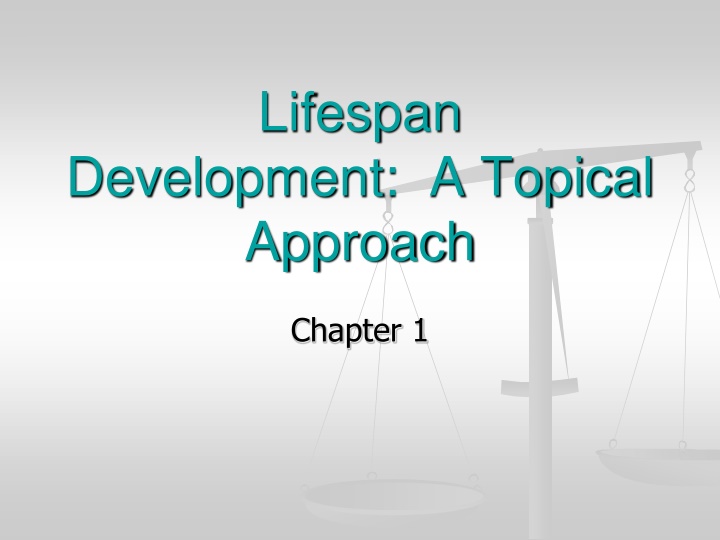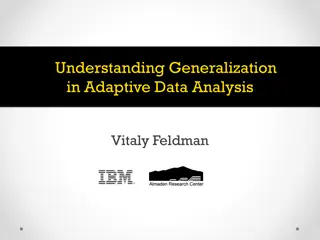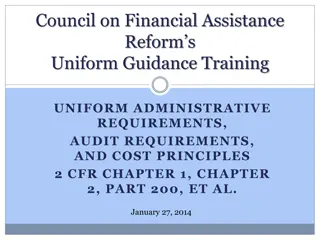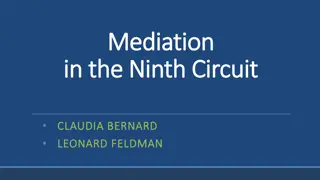
Understanding Human Development Across the Lifespan
Explore the concept of human development through various stages of life, from infancy to old age. Delve into the factors influencing growth, transition, and decline, and understand how different disciplines contribute to research in this field. Discover the historical perspectives on human nature and the influences shaping our worldview.
Download Presentation

Please find below an Image/Link to download the presentation.
The content on the website is provided AS IS for your information and personal use only. It may not be sold, licensed, or shared on other websites without obtaining consent from the author. If you encounter any issues during the download, it is possible that the publisher has removed the file from their server.
You are allowed to download the files provided on this website for personal or commercial use, subject to the condition that they are used lawfully. All files are the property of their respective owners.
The content on the website is provided AS IS for your information and personal use only. It may not be sold, licensed, or shared on other websites without obtaining consent from the author.
E N D
Presentation Transcript
Lifespan Development: A Topical Approach Chapter 1
Orientation What is Human Development? It is a pattern of movement and change Some things change Some things stay the same Movement & change include growth, transition, and decline.
The Lifespan Perspective History Studied child development since about 1900. Studied adult development since about 1960. The reason for the difference is cultural change & increased longevity (life expectancy).
Life Expectancy Changes Lifespan, the maximum number of years a human being could live (about 120 years) remains relatively constant. Life expectancy, the number of years a person can expect to live when born in a certain place in a certain year, changes. U.S., 1900 47 years U.S., 2005, 77 years (30 year increase)
Lifespan Research is Multidisciplinary Where did this information come from? Research and study in many fields of endeavor including psychology, sociology, anthropology, education, and medicine.
What types of influences form the context of development? Normative age-graded (cultural) e.g., puberty, graduation, retirement Normative history-graded (historical) e.g., war, famine, earthquakes, terrorism Non-normative life events & conditions (personal) Individual experiences, biology, personality
Assumptions In order to discuss or examine phenomena or issues, we must make assumptions. If we do not make the same assumptions, we need to know that and not waste time talking past one another.
Worldview Collective assumptions about how the world operates or should operate Examples: socialist vs. capitalist Origins: evolution, creation, intelligent design, pan-spermia (ancient aliens), don t know
Historical Views of Human Nature Prevailing views of children (human nature) throughout history? Preformationism Original Sin Tabula Rasa Innate Goodness How does each view affect child-rearing practices?
Historical View: Preformationism Time: 6th15thCenturies View: Children are basically small adults without unique needs and characteristics. Effect: Little or no need for special treatment
Historical View - Original Sin Time: 16thCentury (Puritan) View: Children are born sinful and more apt to grow up to do evil than good. Effect: Parents must discipline children to ensure morality and ultimate salvation.
Historical View - Tabula Rasa Time: 17thCentury, philosopher John Locke (behaviorist) View: Children are born blank slates and parents can train them in any direction they wish (with little resistance). Effect: Shaping children s behavior by reward and punishment.
Historical View Innate Goodness Time: 18thCentury, philosopher Jean Jacque Rousseau (humanist) View: Children are noble savages who are born with an innate sense of morality. Effect: Parents should not try to mold them at all.
Issue: Nature vs. Nurture Nature = biological inheritance (genetics) Rousseau (humanists) Nurture = all experience Locke (tabula rasa) Is that all there is? (Is it neither?) Are they separable? Is it both? What is epigenetic theory? Interaction of nature and nurture
What does age have to do with it? How many ways can we conceptualize (think about) age? Chronological age: years since birth Biological age: health; vital organ capacity Psychological age: adaptable; learning; flexible; good judgment Social age: roles, expectations
What are the periods (age groups) of development? These are not standard across textbooks. However, they roughly agree. Prenatal - conception to birth Infancy birth to about 2 years Early childhood about ages 2-6 (preschool) Middle & late childhood about ages 6-11 Adolescence ages 10-12 or puberty until about ages 18-22 or independence
What are the periods (age groups) of development? Early adulthood ages 20/25 40/45 Middle adulthood ages 40/45 60/65 Late adulthood ages 60/65 on Young old: 65-84 Oldest old: 85+
To what extent are we becoming an age-irrelevant society? People s lives are more varied. We have a loose social clock. The frequency of reported happiness is about the same for all ages. (78%)
Theories (Perspectives) of Development Psychoanalytic /Psychodynamic Freud: unconscious mind; sexual motivation Personality formed by age 6 Erikson: eight socioemotional stages in the life-span (very influential; not very scientific/testable) Behavioral (tabula rasa) Classical conditioning (automatic learning from experience Operant conditioning (reward & punishment) Social-cognitive learning (observation & imitation) (very testable, but ignores individual differences)
Psychoanalytic Theory: Erik Erikson (1902-1994) Eight psychosocial stages in the lifespan Trust v. mistrust Autonomy v. shame/doubt Initiative v. guilt Industry v. inferiority Identity v. confusion Intimacy v. isolation Generativity v. stagnation Integrity v. despair
Review of Theories Recommendations: We will not be studying these theories directly in this course. However, their general principles may be referred to in explaining developmental events or processes. If you feel that you need to review them, I would recommend: 1. your textbook 2. any Introduction to Psychology textbook 3. www. allpsych.com 4. http://webspace.ship.edu/cgboer/perscontents.html 5. Google the word in question, e.g., psychoanalysis, ethology, B. F. Skinner, etc.
MODULE 1.3 RESEARCH METHODS
Posing Developmental Questions What is a theory? How can a theory be tested?
Data Where do we get our data? What information are we going to believe?
What do you know about? Experimental studies Hypotheses Independent and dependent variables
The Scientific Method Formulating an explanation Carrying out research that either lends support to the explanation or refutes it Identifying questions of interest
Hypothesis Can you think of a hypothesis related to grades assigned in this class? How could your hypothesis be tested?
Choosing a Research Strategy: Answering Questions Correlational research Experimental research
What are the techniques of collecting data? Observation Survey/interview: asking questions Standardized Tests Physiological Measures Case Study Life-history records
Research Designs Descriptive includes more detail Correlational numbers show strength & direction of relationship Used for prediction Ranges from -1.00 to +1.00 (+ is direct; - is inverse); Remember: correlation does not equal causation Experimental
Experiments Manipulation in experiments means there is different treatment in different groups. The experimental group experiences the real treatment or manipulation. Control groups do not; they are for comparison. ( Placebo controls get a fake treatment.) Random assignment of participants to groups ensures that groups start out the same.
Experiments Provide Evidence of Cause-Effect Relationships This is because of control and manipulation. One situational factor (Independent Variable) is manipulated. A behavior (Dependent Variable) is measured. All other factors are held constant or the same in all groups. (This is control.) A change in the dependent variable (behavior) could only be caused by manipulation of the independent variable because all else was controlled.
Experiments: Determining Cause and Effect Experiment Groups Treatment/experimental Control Variables Independent Dependent Random subject selection and assignment
Why aren't experiments always used? Logically impossible Ethically impossible
Research on How People Change across the Lifespan Cross-sectional research: People of different ages are measured in the same year. Cohort effects may occur. These are differences due not to common age, but common experience Longitudinal research: The same people are repeatedly measured across different years. Expensive, time-consuming, dropouts
Research on How People Change across the Lifespan Sequential or cross-sequential research: a combination of cross-sectional and longitudinal People of different ages are measure the first year. Then at intervals (e.g., 1, 5, 10 years), the same people are measured again and new groups are added.
Measuring Developmental Change Longitudinal Studies Measuring individual change Cross-Sectional Studies Measuring people of different ages at same point in time Sequential Studies
Figure 1-4. Research Techniques for Studying Development
Correlational Studies Do not prove causality Do provide important information Correlation Coefficient
Types of Correlational Studies Naturalistic observation Ethnography Case studies; surveys Psychophysiological methods EEG, CAT fMRI
Complementary Approaches Theoretical research Applied research
Consider this What are some policy issues affecting children and adolescents that are currently being debated nationally? Despite the existence of research data that might inform policy about development, politicians rarely discuss such data in their speeches. Why do you think that is the case?
Thinking Critically about Expert Advice Who are the experts in your life? What expert advice have you received about going to college? Why (or why not) did you value or use this advice?
Becoming an expert about experts! Consider the source. Evaluate credentials. Understand difference between anecdotal and scientific evidence. Find details of research-based advice. Do not overlook cultural context of information. Recognize that popular consensus does not guarantee scientific validity.
It is better to have data, but. . Data is no guarantee of accuracy. Did you do it right? Did you interpret it right? Did you fudge the results on purpose? Could anyone replicate it? Was it correlational? Can it even be researched?
So what do we do with other information? Ancient aliens: Do we discount as mythology? Does archeology count? Piaget & Freud mere observation
How do we use data? Don t use it to turn your mind off. Don t ignore it Stop to think why you accept information or not Question yourself as to why you believe it Logic, evidence, want to?
Ways to be Confused Too little information Too much information Deliberately sowing false information or irrelevant information
How Do We Know? Or Do We Just Believe? Robyn Dawes Why believe that for which there is no good evidence? http://www.fmsonline.org/dawes.html (Or possibly evidence to the contrary?) Most of what we know, we actually believe that we know from authority and consensus.






